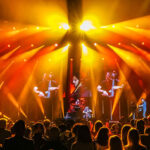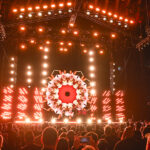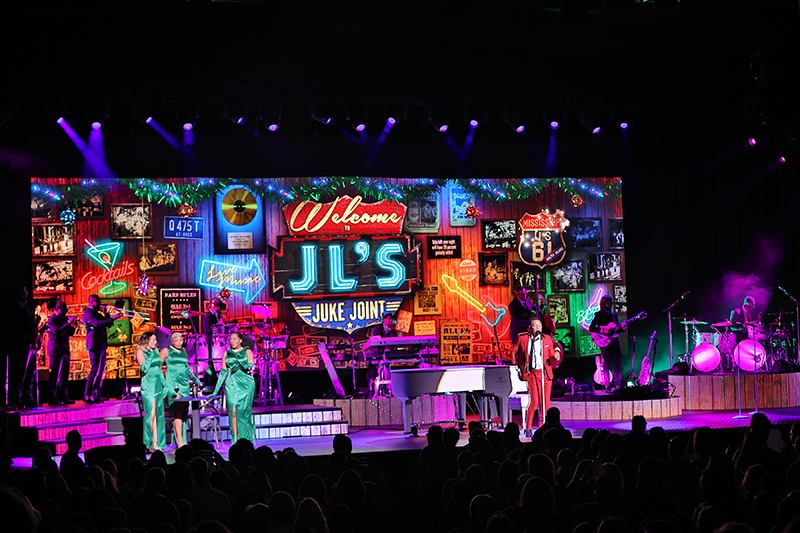
Storyteller Rob English Designs a Holiday Tour
In late October, John Legend released his sixth studio album, A Legendary Christmas, with reworked holiday standards mixed in with six original songs. In November and December, he took his Christmas show on the road with a special production designed by Rob English, one of the partners involved in a company out of Los Angeles called Friends at Work.
As Rob explains, “I’ve always been what I call a storyteller.” Most in the live event industry might prefer a job title such as “creative director,” but not English. “I started storytelling back in high school,” says the Chicago native who adopted Los Angeles as his hometown so long ago he considers himself a Californian. “By the late 1980’s, I was working on the high school paper where I learned layouts, installations and all the tricks we could with the advent of Mac computers. I basically learned how to design with my hands. This eventually led to a job in advertising, which led to working with various artists including musicians.”
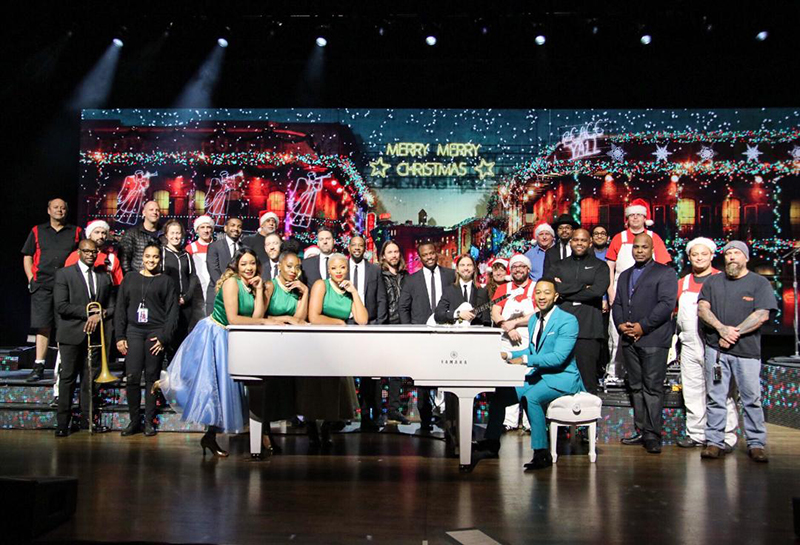
Friends At Work was founded in 2015 with the mission of curating and supporting culturally transformative artists and initiatives. It is all about creating a 21st century entertainment, innovation and social impact company that supports programs for positive change. They work on projects such as #freeamerica, the Show Me Campaign and Native Americans in Philanthropy. Included in all this is the management of several musical artists. About four years ago, Rob started doing some creative work with John Legend, who has been managed by Friends at Work founder and CEO Ty Stiklorius for many years.
“Everything we do is about the intersection of entertainment, culture and impact,” English says. “A few years ago, John went out on an arena tour where we had tons of modern technology to augment a big show. This go around we were looking at a more intimate show that would play theaters. The tricky part was designing a holiday show that wasn’t generic. I wanted to do something different. We are all used to the same shows congested with a lot of the usual visuals. We yearned for something original.”
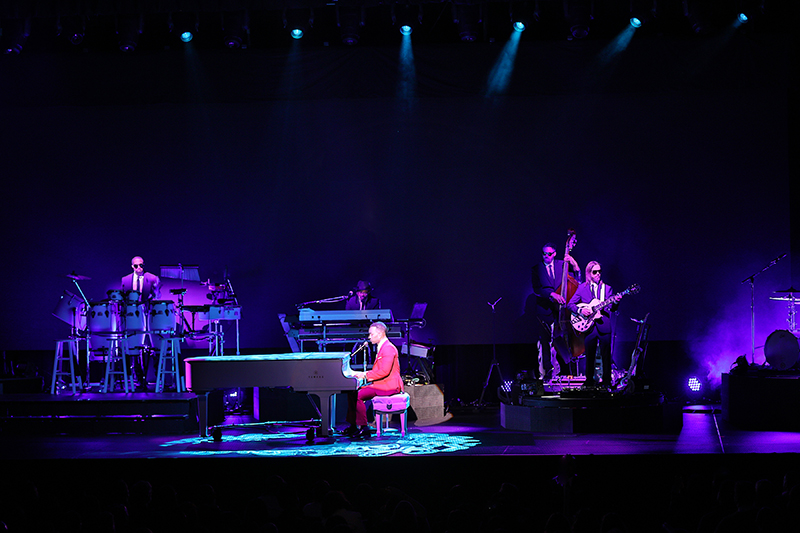
The Visual Narrative
As a self-described storyteller, English adds, “I deal with every visual discipline from the show’s content to graphic video to telling a compelling story that drives people’s emotions.” With that in mind, English thought back to the history of Christmas music as America knows it. “Much of the popularity of this holiday music started back in the 1950’s, and continued through the next couple of decades. I had this thought of starting the show with a tribute to some of these old songs.”
A Legendary Christmas starts with a sheer scrim in place downstage and an opening video of John performing “Chestnuts Roasting” similar to the way Nat King Cole did his version more than 60 years ago. “We filmed John singing the song in black and white, with the media massaged to look a little grainy, like the films of old. As the video ended, the scrim flew out revealing John and the band. My idea was to start the next few songs in some basic white and minimalistic color looks.
“I did a lot of research in putting this show together,” Rob explains. “The album is steeped in the prominent music of those times I spoke about — we wanted to pay tribute to that time period. When we thought about music and variety type shows of the 1950’s, I thought of the Ed Sullivan Show and American Bandstand in terms of video content, the stage set and how we could play off that. If you think about it, John is today’s version of a Nat King Cole. As the show progressed, we incorporate the 1960’s Motown vibe into songs as we embrace that era, including R&B, choreographed background singers and horn players dancing.”
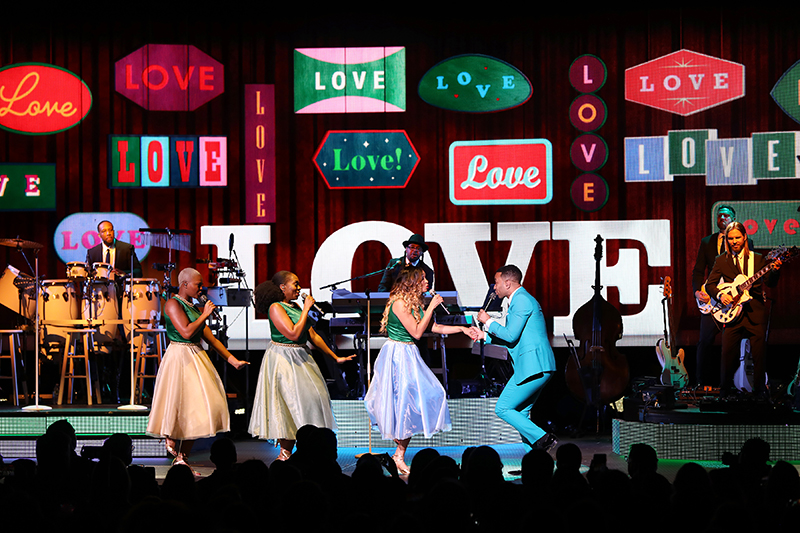
The mid-20th century staging design consisted of some individual circular risers for five of the band members. There were also two staggered risers offstage with the three-piece horn section on one and the three female backing vocalists on another. Members of the 11-piece band were all located just upstage of the center piano. Gallagher Staging, a longtime vendor for this artist, provided the set. “We chose to use the video with the set to create an illusion that we have a constant array of stage sets,” English says, noting how the band would play in front of a juke joint during an upbeat Motown song to add to the show’s theme.
The risers and step units were lined with LED displays that matched resolution with the upstage video wall. English’s design called for a 40-foot-wide LED wall that was only approximately 10 feet tall. “We thought of the rear wall as a digital backdrop that the band played in front of, but it never overpowered the production. In fact, the rear light truss is trimmed at about 18 feet high.” There were no cameras in use, just the content specifically designed for this show. LMG provided the disguise 4×4 media server and all the LED displays for the show. Friends At Work likes using them when possible. The disguise server would be run with time code, but the lighting was not. John is known to stop playing and talk to the audience at times, so this process made sense. The Pro Tools rack backstage fed the server.
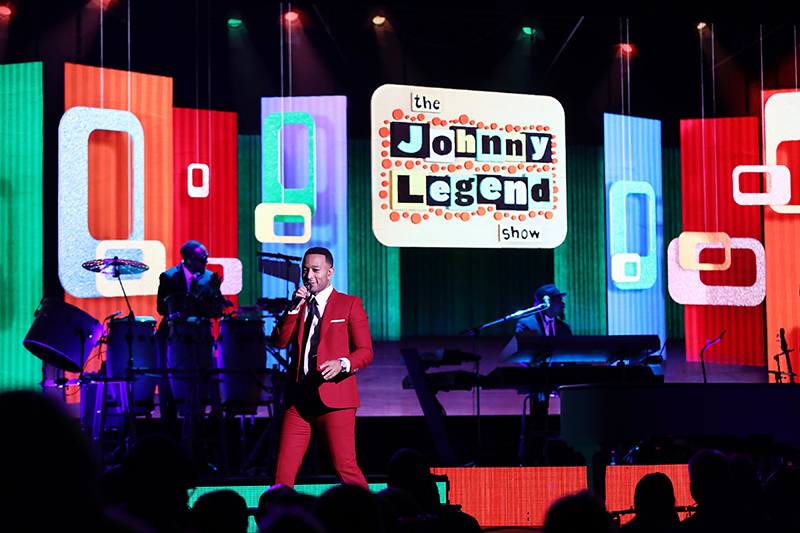
The media content was made under Rob’s direction. He utilized the skills of We are Shop from the U.K. and Sing Sing from Los Angeles. Friends at Work added additional content and editing, with a team of artists on hand at tech rehearsals working on the media as it was programmed with the lighting.
Over the period that English has worked with the Legend family, he’s come to realize that everything they do has to look sharp, or what he refers to as “High Fashion.” John Legend and Chrissy Teigen, Rob notes, “come from a star-powered world, and the costumes on stage needed to reflect an element of class. We needed the show to feel Christmas-y, but not be seen as too apparent. The content was crisp, as was the lighting. We did take advantage of some old theatrical gags as well. We flew in a red Austrian curtain for the section of the show that was just John serenading the crowd from his piano. But that led to a dramatic reveal of the band a second time. We opted to not use today’s soap suds-type snow machines, going instead with the old tried-and-true way of putting confetti in a diaper (a folded cloth hung off a flying batten) that had holes cut in it. When the fly man shook the rail, the faux snow fell through the holes. It actually worked and gave us a salute to old fashioned theatrics.”
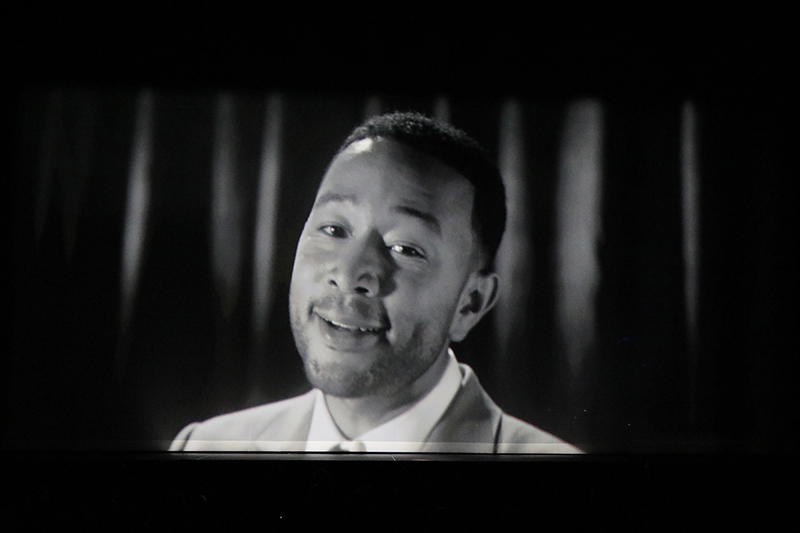
Rob designed a basic lighting grid that included a front and rear truss along with some side lighting. The rig was full of only hard edge light fixtures that were all Robe BMFL spots and Martin MAC Viper AirFX. Some footlights helped illuminate the band members while a row of Mac Auras provided shafts of color from the upstage floor. Once the plot was done, production manager Chris Stinebrink handed it off to Upstaging, the preferred vendor of John Legend for the last five tours. By using Upstaging, Stinebrink was able to secure the exemplary previz suite for a week of tech rehearsals that Rob and his design team could use to get the show together.
Lighting director Hal Deiter has been behind the grandMA2 lighting console for most of Legend’s shows the last few years. Stinebrink called him back in to direct the tour, which included calling all the fly cues along with spotlights. “The one thing we didn’t get together until the last minute was an actual lighting designer to help bring my vision to fruition,” explains Rob. “I knew the video content and flow I wanted, but we needed someone to make the looks shine and orchestrate the movement of the lighting.
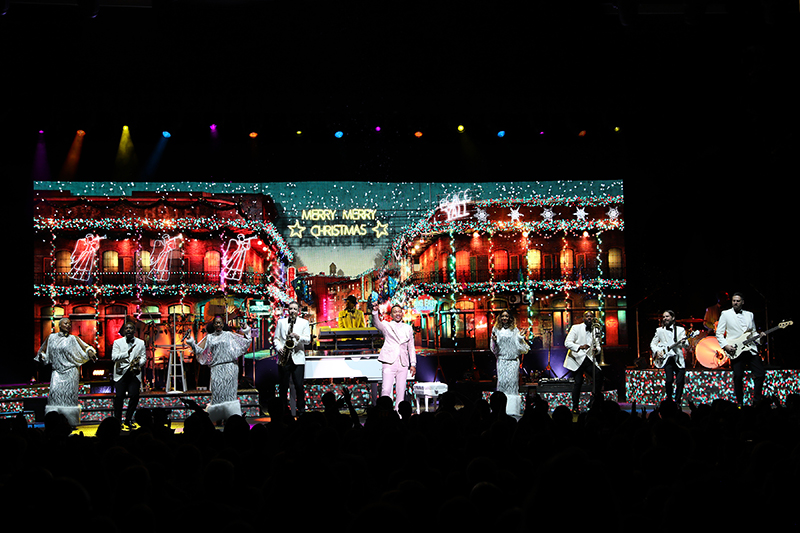
“Jay Dub [a.k.a. tour manager John Warren] suggested we bring in Nook Schoenfeld, who has worked with John [Legend] several times in the past,” English continues. “Jay lauded his use of color and knowledge of what the artist likes. I did not know Nook before I met him, but it was a pleasure watching how he systematically worked and came up with ideas. I would give simple instructions on colors and what I was looking for, then leave him to his art. This production has his fingerprints all over it.”
The creatives all met up at the Upstaging facility, where the two-person lighting team had hung the lights. “We arrived fully expecting to take advantage of their previz system and run our media content through that. But the rig was flown. Lights were already focused, and they were writing cues with some direction from one of my assistants,” Rob says. “We were able to see the lights, but could only view the video content from the playback monitors. John Huddleston walked in on the third day to see how we were doing. Nook mentioned in passing that it was a little rough trying to visualize what the media was doing while he programmed. It didn’t make sense for us to ship the LMG video wall from Florida to Chicago and back, just for tech rehearsals. But the next thing you know, Huddleston offers to have his shop fly a 7mm LED wall upstage of the lights. An hour later, we were all set and in a groove. I am very thankful to them. Had they not done that, I have no doubt that our show would have looked a lot different.”
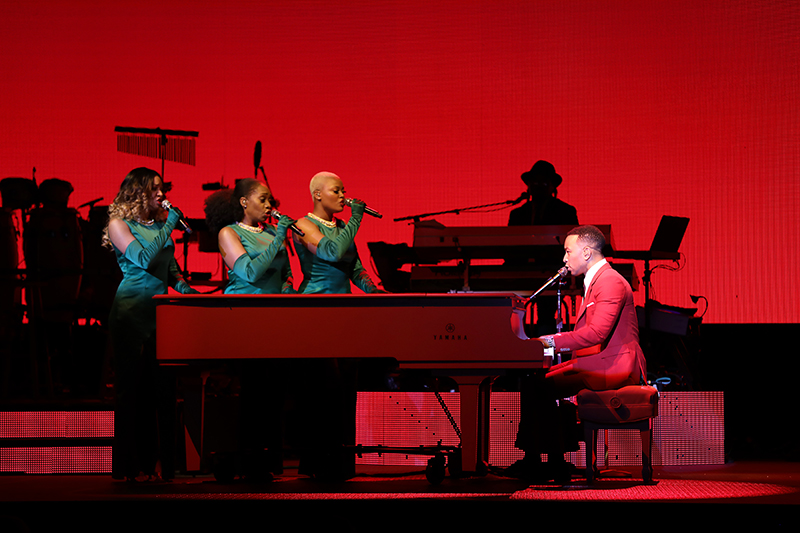
Creative Collaborators
English describes the creative process as a “collaboration of many individuals. As we work up the rungs, we add pieces until we reach the top or pinnacle of each musical number. We constantly push each other. ‘What if we altered the video or simply adjusted the speed? What if we change the light cues to add more accents to parts?’ Everyone thought outside of the box on this production. All along, we kept in mind that this show is all about love, cheer and memories. We tried to tap into that nostalgia. This is where color plays such a big role. The content and lighting takes people on a ride through their own memories.”
When he first came up with the concepts of the show, English started out with just some words and visuals. “I put together a deck that would bring the vision of the album to life. I sat down with John, and he loved the concept from the outset.” Summing up, English admits that, “going into it, we created a vision and a theory for the production, but we didn’t know if it would work. It wasn’t until I got to tech rehearsals at Upstaging that I realized it might just work. I worked on all the costumes, the set, the video content, worrying the whole time. It was a pleasure to see it all came together.”
